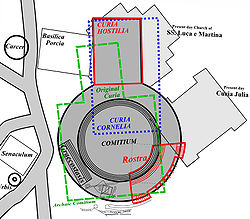- Curia Cornelia
-

These articles cover Ancient Rome and the fall of the Republic Roman Republic, Mark Antony, Cleopatra VII, Assassination of Julius Caesar, Pompey,
Theatre of Pompey, Cicero, First Triumvirate Three generations of Roman Curia. The original Curia as built by Hostus Hostilius in green, the Curia Cornelia, built by Lucius Cornelius Sulla in blue and the Curia Hostilia, built by Tullus Hostilius in red.
Three generations of Roman Curia. The original Curia as built by Hostus Hostilius in green, the Curia Cornelia, built by Lucius Cornelius Sulla in blue and the Curia Hostilia, built by Tullus Hostilius in red.
The Curia Cornelia was a place where the Roman Senate assembled during ca. 80–50 BC. It was the largest of all the Curia (Senate Houses) built in Rome. Its construction took over a great deal of the traditional comitium space and brought the senate building into a commanding location within the Roman Forum as a whole. This was the Senate House of the time of Caesar and is significant because its location was moved by Caesar in order to diminish the Senate's dominance within the City and Republic.
History
In 80 BC Lucius Cornelius Sulla decided to enlarge the existing Curia to accommodate the doubling of senators in the Republic. To do this he had to demolish the old Curia Hostilia and the Comitium. It kept the name Hostilia.
The Curia Hostilia was again destroyed during riots at the funeral of Publius Clodius Pulcher in 52 BC. It was rebuilt again by Faustus Sulla, a descendant of L. Cornelius Sulla, and took the name Curia Cornelia.
In 44 BC the Curia was converted into a temple by Julius Caesar during his redesign of the Forum. It is not known when the building was finally torn down, but due in large part to its location in relation to the Forum of Caesar, it would more than likely have been during or after the construction of the first Imperial Forum.
Finally, Caesar replaced the Curia Cornelia with the Curia Julia (which still stands) in 44 BC.
External links
Categories:- 1st-century BC architecture
- Roman Forum
- Ancient Rome
Wikimedia Foundation. 2010.
